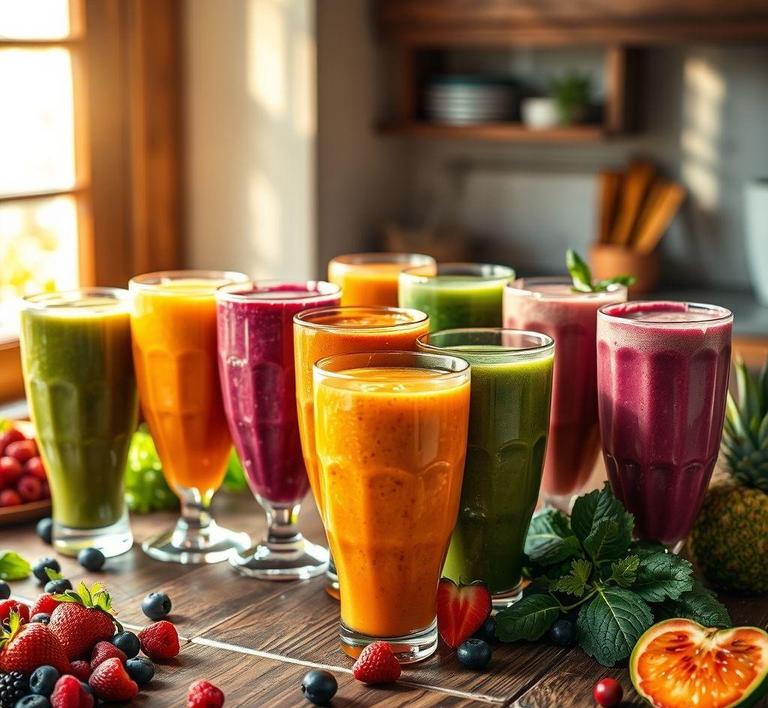So, you’ve got a stash of Daily Harvest smoothies in the freezer and you’re wondering – can I refreeze them? Great question! Refreezing smoothies, especially the ones from Daily Harvest, can be a bit tricky, but totally doable if you follow the right steps. In this guide, we’ll walk you through everything you need to know to keep your smoothies fresh and delicious, without compromising their taste or texture. Whether you’ve had a little too much or just want to preserve them for later, we’ve got you covered with tips and tricks to make the most of your frozen treats.
Can You Refreeze Daily Harvest Smoothies?

Daily Harvest smoothies are a popular go-to for health-conscious individuals seeking convenience without sacrificing nutrition. They arrive frozen and ready for blending, filled with a curated selection of fruits, vegetables, seeds, and superfoods. But life happens. Sometimes you might thaw a smoothie and not end up consuming it immediately. That leads to the pressing question: can you refreeze a Daily Harvest smoothie?
The short answer is yes, you technically can refreeze Daily Harvest smoothies, but there are important considerations involved. Refreezing any food product that has been thawed carries both safety and quality implications. With smoothies specifically, the issue lies less in safety (assuming they were thawed in a refrigerator and not left out too long at room temperature) and more in texture, taste, and nutritional integrity.
Daily Harvest products are flash-frozen shortly after being prepped, preserving nutrients and flavor in their peak state. Once thawed, the breakdown of the natural structure of fruits and veggies begins. Refreezing can intensify this degradation, resulting in a product that may not be as vibrant or palatable upon re-blending.
How To Refreeze Daily Harvest Smoothies?
If you find yourself with leftover smoothie contents-say, you blended more than you needed or simply changed your mind mid-prep-there are a few best practices you should follow to safely and effectively refreeze your Daily Harvest smoothie.
-
Assess the State of the Smoothie:
If the smoothie has been sitting at room temperature for more than two hours, it’s best to discard it. Bacteria can multiply rapidly in that time frame, especially in nutrient-rich environments like fruit-based smoothies.
-
Cool It Promptly:
If the smoothie has been refrigerated and is still cold, transfer it immediately into a freezer-safe container. Avoid glass jars unless they are labeled freezer-safe, as freezing liquid can cause breakage. Opt for BPA-free plastic containers or silicone molds.
-
Leave Headspace:
When freezing liquids, remember that they expand. Leave about an inch of headspace in the container to avoid cracking or spilling.
-
Label and Date:
For best quality, consume your refrozen smoothie within 1-2 weeks. While it will remain safe for longer if kept at 0°F (-18°C), flavor and texture can suffer with prolonged storage.
-
Reblending Optional:
When you’re ready to enjoy your refrozen smoothie, you can either let it thaw in the fridge overnight or pop it into the blender again with a splash of plant-based milk to revive its original texture.
Quality Impact
Now let’s talk about what really matters to most Daily Harvest fans: the quality of the smoothie. While refreezing is a viable option, it does come with compromises.
-
Texture Changes:
Freshly blended smoothies from frozen ingredients tend to be thick, frosty, and luxuriously smooth. Refreezing a blended smoothie disrupts that mouthfeel. Upon re-thawing, the ingredients may separate, resulting in a thinner, more watery consistency. You might also notice a bit of grittiness or pulpy texture from fruits like bananas or berries that don’t take well to multiple freeze-thaw cycles.
-
Flavor Degradation:
The vibrant, fresh flavor you get from a freshly made Daily Harvest smoothie can diminish upon refreezing. Some fruits, particularly berries and tropical varieties like mango or pineapple, can lose their brightness and develop slightly fermented or muted notes.
-
Nutrient Loss:
Although freezing helps preserve nutrients, the combination of thawing and refreezing can cause some further breakdown of sensitive vitamins, particularly vitamin C and some B vitamins. The impact isn’t massive, but it is notable if you’re consuming smoothies for their nutritional punch.
-
Visual Appeal:
Let’s face it-smoothies are as much about the experience as they are about nutrition. A refrozen smoothie might look duller, more separated, and less appealing than one blended fresh from the frozen pack.
Refreezing Daily Harvest smoothies is entirely possible, and when done safely, it won’t harm you. However, the sensory experience-the creamy texture, the bright flavors, the visual vibrancy-may suffer a bit in the process. If convenience is the priority and you’d rather not waste your smoothie, refreezing is a great option to extend its usability. Just manage expectations: it won’t quite be the same smoothie you originally fell in love with.
To maintain the highest quality, consider portioning your smoothies before blending or freezing leftovers in popsicle molds for a fun twist. That way, you still get the nutritional benefits with a bonus of variety-and minimal waste.
Is It Safe To Refreeze Daily Harvest Smoothies?
Refreezing Daily Harvest smoothies is generally safe-under the right conditions. These ready-to-blend smoothie cups arrive frozen and are designed for long-term freezer storage. However, once thawed, the story becomes more nuanced.
The safety of refreezing largely depends on how long the smoothie has been out of the freezer and the temperature it reached during that time. If the smoothie thawed in the refrigerator and remained below 40°F (4°C), it’s usually safe to refreeze. On the other hand, if it sat on your kitchen counter or was left in a delivery box on a warm porch for an extended period, refreezing is not recommended. When plant-based ingredients like fruits and leafy greens warm above 40°F, they enter the ‘danger zone’ (between 40°F and 140°F), where bacteria multiply rapidly.
Another consideration is texture and quality. Daily Harvest smoothies consist of flash-frozen fruits, vegetables, and superfoods. Thawing and refreezing can cause ice crystals to form, rupturing the cellular structure of ingredients like berries and bananas. This may not make them unsafe, but it can result in a mushy or less appetizing texture upon blending.
Signs That Daily Harvest Smoothies Should Not Be Refrozen
While your instincts might nudge you to "save" a thawed smoothie cup by tossing it back into the freezer, certain signs indicate that doing so may not be safe:
- Off Smell: A sour, fermented, or otherwise “off” aroma is a major red flag. Naturally sweet fruits should never emit an unpleasant scent.
- Discoloration: If the fruits or greens inside the cup appear brown, gray, or unusually faded, this may suggest spoilage due to prolonged exposure to heat.
- Texture Changes: Excess moisture pooling at the bottom or an unusually slimy texture on solid ingredients can signal that the smoothie has partially broken down-inviting microbial growth.
- Package Bloated or Puffed: This can be a result of gases released by bacterial activity. If your cup seems swollen or distended, discard it immediately.
- Time Left Out: Even if you don’t see any obvious signs, if your smoothie cup sat out for more than 2 hours at room temperature (or 1 hour if above 90°F), it’s safer to throw it out than refreeze.
Common Refreezing Mistakes
Even with the best intentions, there are common pitfalls people fall into when attempting to refreeze smoothies:
- Refreezing After Partial Thawing on the Counter: Many believe that if the ingredients are still “a little icy”, it’s fine to pop them back in the freezer. Unfortunately, bacteria can start growing before the ingredients fully thaw.
- Using the Microwave to “Soft Thaw”: Microwaves create uneven heat pockets, and certain parts of the smoothie cup may reach unsafe temperatures even if others remain frozen. This not only compromises texture but invites bacterial growth.
- Repeated Freeze-Thaw Cycles: Constantly thawing and refreezing damages ingredients and increases the risk of contamination. Once thawed, a smoothie should ideally be consumed or discarded.
- Forgetting to Seal the Cup Properly: If the original cup is not tightly resealed or placed in an airtight container before refreezing, it can suffer freezer burn or absorb odors from other frozen foods.
Tips And Tricks
Handled correctly, refreezing doesn’t have to be a deal-breaker for your smoothie game. Here are some strategies to maximize safety and minimize waste:
- Thaw in the Fridge: Always thaw your smoothie cups in the refrigerator rather than on the countertop. If plans change, and you can’t blend it right away, you have a window of time to safely refreeze it.
- Portion Smart: If you only need half a smoothie, scoop out what you need while still frozen and return the rest to the freezer immediately. Avoid exposing the whole cup to air and room temperature.
- Use Ice Cube Trays: For smoothies that have already thawed but are still cold and safe, consider blending and freezing the liquid into ice cube trays. Later, you can pop a few cubes into a blender with plant milk for a quick refreeze-friendly smoothie experience.
- Label & Date: If you decide to refreeze a smoothie, clearly mark it with the date so you don’t exceed a safe consumption window. Consume refrozen smoothies within 1-2 weeks for best quality.
Conclusion
Refreezing Daily Harvest smoothies is safe when done correctly-but it requires attention to temperature, time, and visible signs of spoilage. While convenience foods like these are designed to simplify your wellness routine, proper storage practices are essential to ensure they remain as healthy and vibrant as intended. When in doubt, remember this simple mantra: ‘When it thaws, the clock starts ticking.’ By staying mindful of safe thawing and refreezing practices, you can enjoy your smoothies with confidence-waste less and nourish more.

